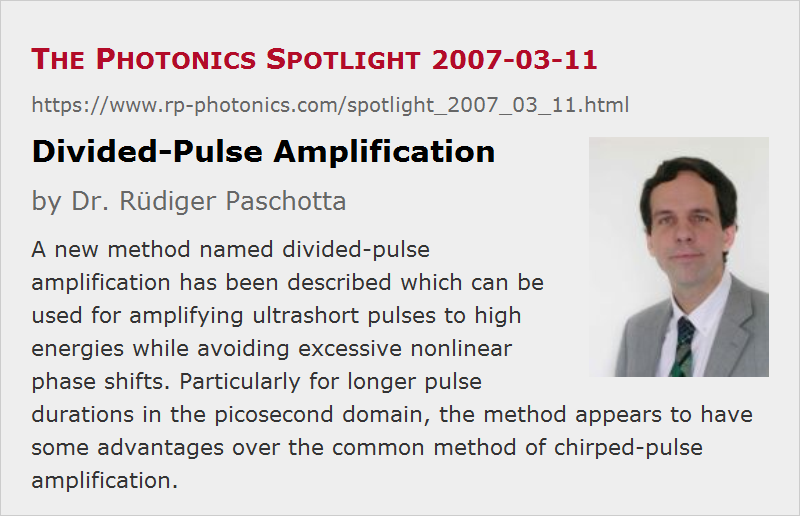Divided-Pulse Amplification
Posted on 2007-03-11 as a part of the Photonics Spotlight (available as e-mail newsletter!)
Permanent link: https://www.rp-photonics.com/spotlight_2007_03_11.html
Author: Dr. Rüdiger Paschotta, RP Photonics Consulting GmbH
Abstract: A new method named divided-pulse amplification has been described which can be used for amplifying ultrashort pulses to high energies while avoiding excessive nonlinear phase shifts. Particularly for longer pulse durations in the picosecond domain, the method appears to have some advantages over the common method of chirped-pulse amplification.

Ref.: S. Zhou, F. Wise and D. G. Ouzounov, “Divided-pulse amplification of ultrashort pulses”, Opt. Lett. 32 (7), 871 (2007); encyclopedia articles on divided-pulse amplification and chirped pulse amplification
A common problem associated with the amplification of ultrashort pulses to high pulse energies is that the high peak powers lead to excessive nonlinear phase shifts and thus to spectral broadening and distortion of pulses. By now, the technique of chirped-pulse amplification has become a well-known solution: one dispersively stretches the pulses, amplifies the stretched pulses (having a low peak power), and recompresses them in a dispersive compressor. This technique, which is often used in high-energy femtosecond sources, is unfortunately not convenient for picosecond pulses, because these would require impractical amounts of dispersion in the stretcher and compressor.
A new paper (Zhou et al., see above) from the group of Prof. Frank Wise at Cornell presents an alternative technique, named divided-pulse amplification, which appears to be most suitable for the domain of picosecond (or slightly sub-picosecond) pulses. The basic idea is to split pulses by sending them through a sequence of birefringent crystals, then to amplify them, and finally to recombine them in the same crystals or another set of crystals. With ten crystals, one would already achieve a 1024-fold reduction of peak power, thus substantially mitigating nonlinear effects.
This approach indeed looks quite interesting. It is rather versatile, since it does not require very special optical components, nor any sensitive alignment (such as that of a dispersive compressor based on a pair of diffraction gratings). In the picosecond domain, one also does not suffer too much from chromatic dispersion. Particularly in conjunction with fiber amplifiers, the technique could constitute a practical solution of the nonlinear problem when generating millijoule-level pulses with durations of a few picoseconds.
A new article in the Encyclopedia of Laser Physics and Technology explains and discusses the method more in detail.
This article is a posting of the Photonics Spotlight, authored by Dr. Rüdiger Paschotta. You may link to this page and cite it, because its location is permanent. See also the RP Photonics Encyclopedia.
Note that you can also receive the articles in the form of a newsletter or with an RSS feed.
Questions and Comments from Users
Here you can submit questions and comments. As far as they get accepted by the author, they will appear above this paragraph together with the author’s answer. The author will decide on acceptance based on certain criteria. Essentially, the issue must be of sufficiently broad interest.
Please do not enter personal data here; we would otherwise delete it soon. (See also our privacy declaration.) If you wish to receive personal feedback or consultancy from the author, please contact him e.g. via e-mail.
By submitting the information, you give your consent to the potential publication of your inputs on our website according to our rules. (If you later retract your consent, we will delete those inputs.) As your inputs are first reviewed by the author, they may be published with some delay.
 |



If you like this page, please share the link with your friends and colleagues, e.g. via social media:
These sharing buttons are implemented in a privacy-friendly way!